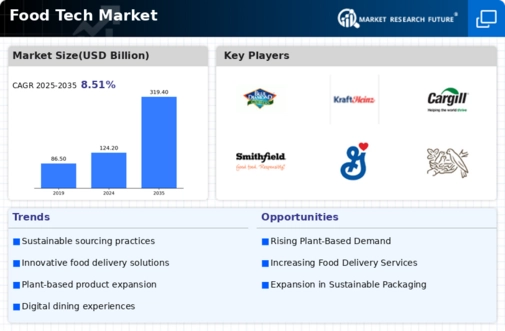Health-Conscious Consumer Trends
The Food Tech Market Industry is witnessing a shift towards health-conscious consumer behavior, which is reshaping product offerings. A significant portion of the population is increasingly prioritizing nutrition and wellness, leading to a surge in demand for functional foods and beverages. Data indicates that the market for health-oriented food products is projected to grow at a compound annual growth rate of 8% over the next five years. This trend is compelling food tech companies to innovate and develop products that cater to specific health needs, such as gut health and immunity. Consequently, the Food Tech Market Industry is adapting to these evolving consumer preferences, which may drive further growth and diversification.
Sustainable Supply Chain Innovations
The Food Tech Market Industry is increasingly influenced by innovations aimed at creating sustainable supply chains. Companies are adopting technologies that enhance traceability and transparency, which are essential for meeting consumer demand for ethically sourced products. According to recent data, approximately 60% of consumers express a preference for brands that demonstrate sustainability in their supply chains. This trend is prompting food tech companies to invest in blockchain and IoT solutions to monitor and optimize their supply chains. As a result, the Food Tech Market Industry is likely to see a rise in investments directed towards sustainable practices, which could lead to improved operational efficiencies and reduced environmental impact.
Regulatory Support for Food Innovation
Regulatory support is emerging as a crucial driver for the Food Tech Market Industry, as governments worldwide are increasingly recognizing the importance of food innovation. Policies aimed at fostering research and development in food technology are being implemented, which could lead to enhanced food safety and sustainability. For example, funding initiatives for food tech startups have increased, with some regions allocating millions in grants to support innovative projects. This regulatory backing not only encourages investment in the Food Tech Market Industry but also facilitates collaboration between public and private sectors. As a result, the landscape for food innovation is likely to expand, fostering a more dynamic and competitive market.
E-commerce and Online Food Delivery Growth
The Food Tech Market Industry is significantly impacted by the rapid growth of e-commerce and online food delivery services. With the increasing reliance on digital platforms for food purchases, companies are investing heavily in online infrastructure to meet consumer expectations for convenience and accessibility. Recent statistics reveal that online food delivery services have seen a growth rate of over 20% annually, indicating a robust shift in consumer purchasing behavior. This trend is prompting food tech companies to enhance their digital offerings and improve customer engagement through personalized experiences. Consequently, the Food Tech Market Industry is evolving to accommodate this digital transformation, which may lead to new business models and revenue streams.
Technological Advancements in Food Processing
Technological advancements are playing a pivotal role in the Food Tech Market Industry, particularly in food processing techniques. Innovations such as high-pressure processing, 3D food printing, and automation are enhancing efficiency and product quality. For instance, the adoption of automation in food processing has been shown to reduce production costs by up to 30%, thereby increasing profitability for companies. These advancements not only streamline operations but also enable the development of novel food products that meet consumer demands for convenience and quality. As a result, the Food Tech Market Industry is likely to experience accelerated growth driven by these technological innovations.


















Leave a Comment